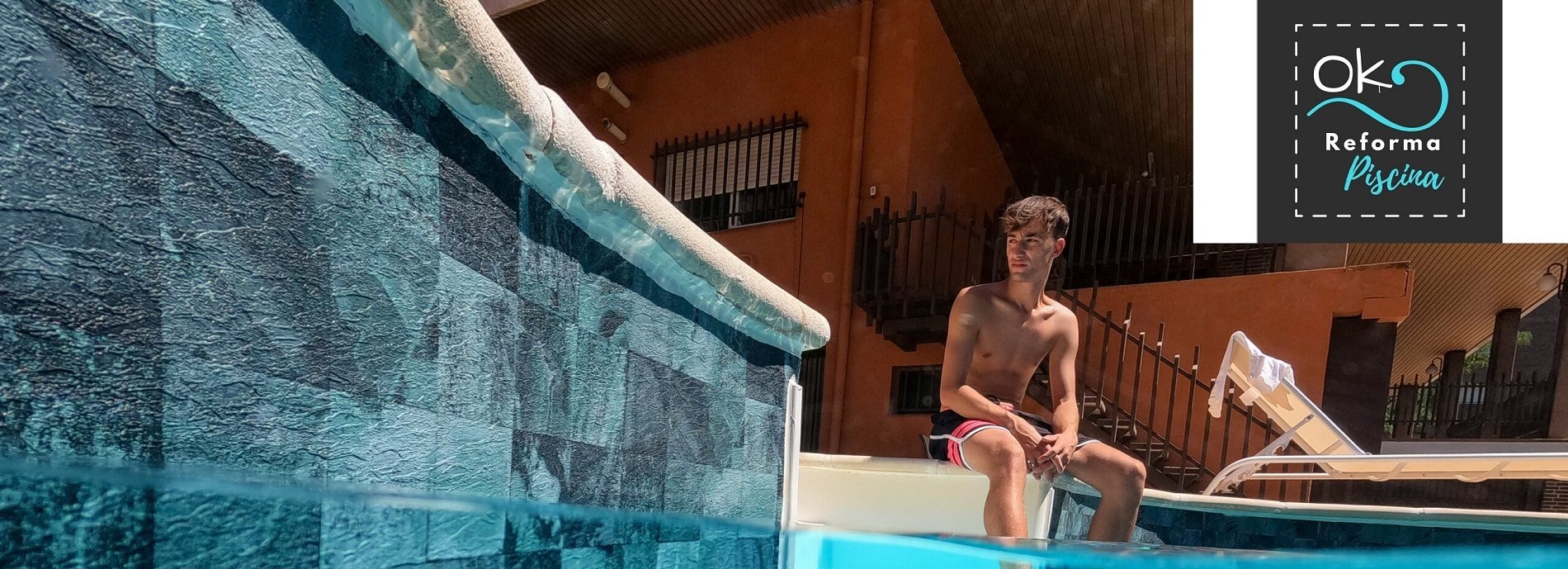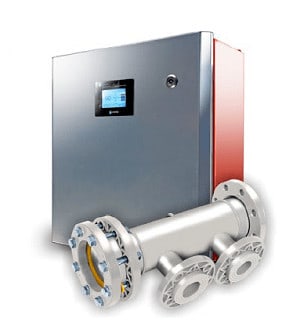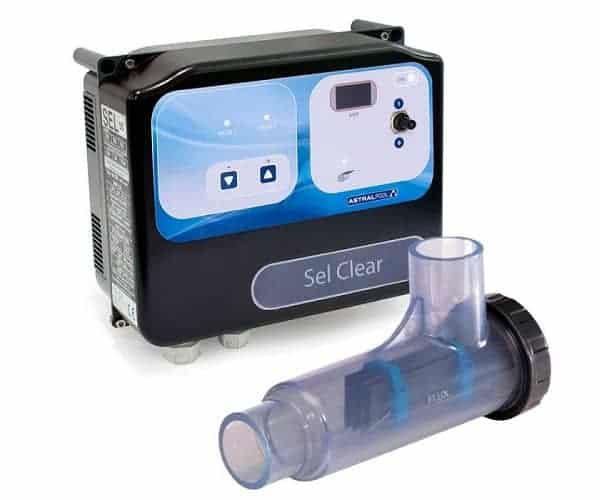
Table of contents of the page
First of all, within Swimming pool water treatment en Ok Pool Reform We present you an entry where you will find all kinds of information about: What is salt chlorination, types of Saline Electrolysis equipment and difference with chlorine treatment.
What is salt chlorination
Basic concept of the salt electrolysis process
Generically, Electrolysis is a simple process through which oxygen, hydrogen and all other components present in water are separated. of the pool by applying a direct electric current.
What is a pool salt chlorinator / salt electrolysis equipment
Which is better salt or chlorine pool to disinfect pools
Advantages of the saltwater pool
What are the Disadvantages of saltwater pools?
How to choose a saline pool chlorinator

Criteria for choosing a salt chlorinator
1st Criterion to choose salt chlorinator: Brand of salt chlorinator with guarantees
- First of all, lThe brand of the salt chlorinator is a very important criterion to evaluate to ensure proper functioning in the future and that in turn we can cover our investment made.
- We would like to make a point that with the passage of time it is very common for certain breakdowns to arise, especially around the salt electrolysis cell.
- Ensure that the manufacturer that grants us the warranty for the purchased product will respond to certain situations.
- Ensure that the manufacturer in question will have spare parts if there are certain breakdowns in our equipment.
2nd Criterion to choose pool salt chlorinator: Power or Production of the Equipment
- The production of the equipment is parallel to good hygiene and disinfection of the pool water.
- Always check how many m3 of water the saline electrolysis equipment is indicated for and also the requirement for how much production it performs.
3rd Criterion to choose salt chlorinator: Additional benefits
Additional features that a pool chlorinator can have
- Firstly, our equipment can have an additional feature of measuring and regulating the pH of the water.
- RedoX control.
- Measurement and control in ppm's of free chlorine.
- Temperature control.
- Domotics
- Polarity change (self-cleaning salt chlorinator)
- Have a control box with IP65 protection against humidity, dust and water.
- Assess whether we are interested in paying the price of a salt chlorinator with a low salt concentration (2g/l) compared to the conventional 5g/l.
- Etc
4th Criterion to choose salt chlorinator: Switching Power Supply
- A switching power supply gives higher performance than a linear supply.
- This means that the chlorinator will have lower electricity consumption and higher production.
- They also generate less heat and can be installed in more restricted technical rooms.
- It will also result in a longer cell life, by having more precise control of output power and working at the optimal point of the curve with chlorine production. That is, the same amount of chlorine produced in less time.
- Having no moving parts, and the power control being through electronic systems, means that there are no mechanisms exposed to deterioration due to corrosion.
5th Criterion to choose saline chlorinator: Bipolar cell
- A bipolar cell gives us greater performance than a monopolar cell, by emitting and absorbing charges of the same sign at the same time.
- The current distribution is more efficient and makes the output greater per ampere.
- The objective is for them to be efficient with respect to the consumption of electrical current.
6th Criterion to choose salt chlorinator: ORP Pool
Types of Saline Electrolysis Equipment

Saline electrolysis for swimming pool
Description of the Saline Electrolysis equipment for swimming pools
- Firstly, we have pool saline electrolysis equipment with self-cleaning titanium electrode.
- Transparent and removable methacrylate cell holder, for easy access to the cell to clean it.
- Furthermore, the connections of the electrolysis pool Ø63.
- As for these saline electrolysis equipment, it performs a salinity test that allows us to determine at any time the amount of salt our pool needs, an indicator on the equipment itself.
- In addition, the Salina pool electrolysis equipment has a numerical display and anti-corrosion ABS housing.
- They are also capable of automatically regulating the production level.
- Finally, they have long-lasting electrodes between 10.000-12.000 hours.

Self-cleaning saline electrolysis equipment
Exclusivity / NEW: Family of salt chlorinator equipment for self-cleaning pools.
What are self-cleaning saline electrolysis equipment?
Self-cleaning saline electrolysis equipment (also called self-cleaning salt chlorinators) They are those who treat the pool with salt and reverse the polarity of the current from time to time. In this way, the dirt comes off the electrodes naturally (thanks to the electrolysis effect itself).
Features and benefits of the self-cleaning salt chlorinator
Water treatments with Saline chlorinators for self-cleaning pools have great advantages to improve the quality of pool water.
- Firstly, the self-cleaning salt chlorinator generates chlorine from the salt dissolved in the water, increasing the safety in the health of bathers.
- Moreover, contains a simple and easy to use control panel, in which it incorporates a tactical color screen that indicates: operating LED, chlorination adjustment button and salt lack indicator light.
- The design of the self-cleaning saline electrolysis pool is compact and robust and has a completely watertight and waterproof casing, therefore, It is suitable for installation in any type of technical room and is especially resistant in aggressive environments.
- Self-cleaning by polarity reversal. At intervals determined by the software included in the device, the self-cleaning pool salt chlorinator reverses the polarity of its electrodes. In this way, this team eliminates any residue existing on the plates, increasing the useful life of the cell and eliminating any type of maintenance.
- Thus, they manage to achieve maintenance automatically, such as chlorine and pH dosing with pumps, since they dose the optimal concentration of chlorine and the acidity of the water appropriately in pool electrolysis
- In addition, They integrate maintenance-free cells with more than 12.000 real hours continuous operation.
- Possibility of integration of different equipment, control functions (pH, ORP, temperature, conductivity, etc.) through modules.
- The self-cleaning salt chlorinator equipment can be easily integrated into other home automation platforms thanks to the fact that they also integrate as standard an RS-485 serial port (isolated).
- PFinally, most self-cleaning pool electrolysis equipment incorporates safety features such as: a gas detector, which stops chlorination in case of insufficient flow, and an alarm that warns if the salt level is low.
- Finally, there are saline electrolysis devices in which there is the possibility of integrating a module through which the client can Access your computer from anywhere through any mobile device connected to the Internet.
How self-cleaning saline electrolysis equipment works

Mpool electrolysis pH module
- On the one hand, we have the control module to convert the equipment into equipment with pH control.
- The pool electrolysis pH module has a kit with a probe, a probe holder, the calibration salt solutions and the pump.
- In this way, the ideal quantities to disinfect the pool are dosed using electromagnetic processes.
MORP module for electrolysis pool
- On the other hand, the electrolysis ORP module controls the chlorine equipment through redox or oxidative reductant.
- Thus, the oxygen in the water is decreased by exchanging electrons.
- And which depends on the pH value, it measures the acidity of the water since it expresses the potential of hydrogen and hydronium ions present.
Pool salt dispenser characteristics + pH and ORP
- Combined equipment for saline electrolysis, pH control and chlorine control through Redox potential (ORP).
- For this reason, the equipment will produce chlorine up to the desired level.
- And, once it reaches that level, it will automatically turn off and turn on when the pool needs more chlorine.
- Transparent and removable methacrylate cell holder, for easy access to the cell to clean it.
- Ø63 connections.
- They include an electrode and electrode holder as well as an electromagnetic dosing pump (non-peristaltic).
- It also performs a salinity test that allows us to determine at any time the amount of salt our pool needs, an indicator on the equipment itself.
- Numerical display and anti-corrosion ABS housing.
- Automatically lowers the production level.
- Finally, it allows external and independent control of the ORP. Long-lasting electrodes between 10.000-12.000 hours.
Next, with one click you can learn more information about the control parameter ORP pool and the methods of measurement (very important in water treatment with saline chlorinators).
Self-cleaning salt chlorinator with polarity reversal
Characteristics Self-cleaning salt chlorinator with polarity reversal
- The self-cleaning salt chlorinator with polarity reversal An alternative is the automatic chlorine and pH control system.
- Actually, it is a quality pool electrolysis equipment that generates savings in the use of chlorine, although it does not eliminate it completely.
- It is known that salt chlorinators are self-cleaning and manage to remove a greater amount of dirt from their electrodes by reversing the polarity of the current.
- Electrolysis integrates cells and without further maintenance, thanks to the fact that the water is cleaned continuously with a salt chlorinator with a pH regulator that is integrated into different types of disinfection modules, to control the factors that alter the quality of the water. .
- It is a treatment that must be calculated taking into account many factors to ensure its perfect functioning.
- The dosing of chlorine and pH with dosing pumps to regulate the chemicals in the water with a salt chlorinator, a free probe and an electrode with a pH regulator, which manages to control the required values, analyzes them and acts on the dosing mechanism to maintain the necessary amount of natural chlorine.

Salt electrolysis with copper and silver ionization
Description of salt electrolysis equipment with copper and silver ionization
- The saline electrolysis process with copper and silver ionization is a powerful piece of equipment that eliminates algae and disinfects the water, increasing the performance of the purification filters and keeping the water transparent.
Advantages of the salt chlorinator with copper and silver ionization
- Firstly, it qualitatively improves the quality of pool water; while it is much healthier, better looking and transparent, clean, shiny and germ-free, without chemical substances and with much less smell than the typical chlorine pool.
- Secondly, note that the salt chlorinator with copper and silver ionization It incorporates a flocculation and anti-algae system.
- Mainly, eliminates the need for chemicals for the treatment of pool water and of course avoids manipulation.
- And, particularly, Pool water maintenance tasks are simplified.
- Additionally, we will notice less chlorine smell and better looking, bright and extremely transparent water.
- Finally, deductibly from what has been said, The cost of pool maintenance will be much lower.
How to install salt chlorinator
Installation of salt chlorinator with pH regulator
To avoid problems of corrosion on the plates that make chlorination You should never inject pH regulators before the cells.
Installation of a salt chlorinator when there is a system to heat the pool water
If you have a system for heat the pool water, It must be installed before the water passes through the filter and the electrodes of the salt chlorinator.
Saline chlorinator installation video with pH regulator
Correct salt water pool values
Ideal levels in the saltwater pool
- pH: 7,2-7,6
- Total chlorine value: 1,5ppm.
- Free chlorine value: 1,0-2,0ppm
- Residual or combined chlorine: 0-0,2ppm
- Ideal pool ORP value (pool redox): 650mv -750mv.
- Cyanuric acid: 0-75ppm
- Pool water hardness: 150-250ppm
- Alkalinity of pool water 125-150ppm
- Pool turbidity (-1.0),
- Pool phosphates (-100 ppb)
Control the value of chlorine in salt pool
How should I perform the calculation to know what production the salt chlorinator should have?
How much salt does a pool need?
Amount of salt per liter of pool water: 4 to 6 grams per liter. Salt balance: 5ppm.
What type of pool salt should I use for my salt chlorinator?
Can we use any type of salt for the pool? Theoretically, almost YES. It is advisable? Absolutely not.
Pool salt quality
Indeed, all those salts that have been more treated and with almost 100% purity those that will provide us with the most benefits.
Obviously, depending on the type of salt we choose, it will cost us one price or another and the more purity it has, the higher the price the purchase will cost us.
Depending on the quality of pool salt:
- The choice of the quality of pool salt will also impact and determine the quality of the pool water.
- And, in turn, it will help us have to depend less on it since it will generate less maintenance.
- Also good quality pool salt makes It will extend the useful life of the chlorinator's electrolytic cells.
Considerations when we want to purchase pool salt
- Pool water volume (m3).
- Location, climate, average pool water temperature.
- Pool water hardness the greater or lesser hardness of the water.
- Assess personal aspects such as: purchasing power, whether it is worth it depending on the use we give to the pool, time available to dedicate to the pool, etc.
Types of salt for salt chlorinators
Sea salt for swimming pools
- Sea salt is a special type of salt for pool salt chlorinators.
Vacuum refined and dehydrated salt for swimming pools
- Vacuum refined salts are those pool salts that have been obtained from a brine (water with salt).
- In addition, through a process of thermocompression and vacuum evaporation they have been chemically purified.
- In this way we obtain a solidified refined and dehydrated salt and They crystallize in a spherical shape.
- On the other hand, the minimum content of vaccum salt in sodium chloride (NaCl) pools is 99,75% purity.
- We could say that It contains almost no insoluble substances.
- For all this, this type of fine dehydrated salt has a greater ease of dissolution.
- And, finally, it exists in all types of formats: powder, pills...
Multifunction pool salt tablets
- This type of salt tablets are composed not only of the salt itself but also of other disinfectant products.
- En Ok Pool Reform We do not recommend them due to the saturation they generate of components of isocyanuric acid in the pool water.
Epsom pool salt
- Epsom pool salts are those that have been taken first-hand from waters with a very high concentration of salt.
- The usual use for Epsom salts in swimming pools is in spa-type places.
Generic pool salt characteristics
- Pool salt is a type of natural, dry, granulated and high quality salt (99,48% Sodium Chloride).
- Salt for swimming pools continues to be white crystals, odorless and easy to dissolve.
- We should buy those bags of salt that meet current European regulations EN-16401, which regulates that pool salt is standardized for use in pools with salt electrolysis systems.
- In addition, it is also advisable for the bags of salt that we buy to be protected under the EN-16401 standard, that is, they are 100% free of anti-caking or anti-caking agents.
- Finally, bags of pool salt must safeguard water quality with an insoluble index of just 0,005% and less than 0,1% of calcium+magnesium.
Pool salt price
Tecno Prodist TECNOSAL Swimming Pools and SPA Pack 2 x 10 kg – Special Salt for Saline Chlorination of Swimming Pools, SPAs and Jacuzzis – In a Bucket Easy Application
[amazon box= »B08CB36MG1″ button_text=»Buy» ]
Thermal salts for Spa, Jacuzzi and Pool. Thermal Bath salium 5 kg. Ideal product for pool and Spa Jacuzzi of any brand (Jacuzzi, Teuco, Dimhora, Index, Bestway, etc.)
[amazon box= »B07FN3FMLL» button_text=»Buy» ]
Enisal 25 kg Sack of Special Salt Salt chlorinator pools
[amazon box= »B07DGQPM82″ button_text=»Buy» ]
25KG BAG OF SALT FOR POOL
[amazon box= » B01CMHHB2S » button_text= »Buy» ]
Pack of 100 Kg (4 Bags of 25 kg.) ENISAL Special Pool Salt – Complies with the European Standard EN 16401/A (Quality A Salt for Saline Electrolysis Pools)
[amazon box= «B07B2SK6FL » button_text=»Buy» ]
Spanish Salinera. Pool Salt – Pool-spa salt salt bag pool salt 25 kg
[amazon box= »B00K0LT8A2″ button_text=»Buy» ]
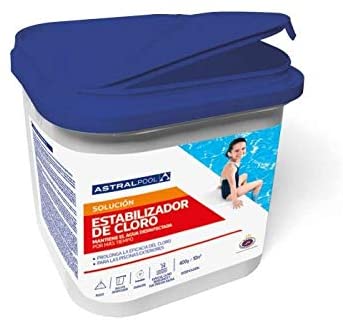 Chlorine stabilizer for salt chlorinator
Chlorine stabilizer for salt chlorinator
Characteristics Chlorine stabilizer for pool chlorinator
- First of all, the chlorine stabilizer for pool chlorinator is actually a special product for salt pools.
- The main function of the chlorine stabilizer for salt chlorination is to maintain the chlorine generated by saline electrolysis for longer.
- In this way, we will extend the disinfection of the pool water.
- Depending on whether the sun hits our pool directly or not, we will save the evaporation of the chlorine generated between 70-90%.
How to use chlorine stabilizer for salt chlorinators
- For starters, it is recommended Add chlorine stabilizer for salt chlorinators at the beginning of the bathing season.
- We will need approximately 4-5 kg of chlorine stabilizer product per 100m3 of water (very important reminder: we must always put the chemical product in the pool skimmer basket).
- Maintain an amount of stabilizer between 30-75 ppm of ctX-401 in the water.
- Maintain an amount of salt between 4 and 5 grams per liter of water in the water.
Ideal value of chlorine stabilizer
The ideal amount of chlorine stabilizer in pool water is: 30-75ppm
Buy Chlorine Stabilizer
Chlorine stabilizer price
Fluidra 16495 – Chlorine Stabilizer 5 kg
[amazon box= »B00K4T0F70″ button_text=»Buy» ]
BAYROL Chlorine Stabilizer for Swimming Pools Stabichloran 3 kg
[amazon box= »B07P7H4CSG» button_text=»Buy» ]
CTX-401 Chlorine Stabilizer (5 kg container)
[amazon box= »B079456P54″ button_text=»Buy» ]
How salt chlorinator works
Operation of the salt chlorinator
Operating steps of the salt chlorinator
Add salt
Electrolysis process
Water conversion
Free chlorine production
Destruction of organic matter and pathogens
Extra in the salt chlorinator: pool orp probe
Currently, there are many salt electrolysis equipment which have an integrated ear probep pool, which is installed in the water return tube to provide us with the measurement of the amount of chlorine or disinfectant present in the pool water.
Finally, we provide you with the direct link to the very important control factor if you have a salt chlorinator: orp pool or in other words redox pool.
Video how a Saline Electrolysis system for swimming pools works
After watching the video, the questions about the salt pool.
- How a salt electrolysis system for swimming pools works
- What are salt pools?
- How they generate their own chlorine.
- Salt "chlorinator" is better than chlorine tablets
- Advantages of the salt chlorinator
How to know if the salt chlorinator works
Water bucket test to verify the operation of the salt chlorinator
- A very simple and effective way to check if the salt chlorinator works is to fill a bucket with water or a bottle and insert the chlorinator electrode inside until the water completely covers it. Note that the connectors should not get wet, so be very careful with the water level, if necessary empty the bottle or bucket.
- We launch the team saline chlorination after a few seconds the water should become cloudy forming a kind of foam generated by the gas particles that are released from the process. In this case it tells us that the equipment is performing the electrolysis correctly and consequently that it is working correctly.
- If you still have doubts about its operation, you can check the chlorine level in the same bucket or bottle of water where you have carried out the checks, this must be very high since the number of cubic centimeters is very small. Another sign of correct operation is a smell similar to that of bleach given off by the bucket or bottle of water where the salt chlorinator is acting.
Other verifications to test the operation of the pool chlorinator
- Confirm the return water flow to make the comparison with the measurement extracted from the water in the pool glass.
- Perform the test outside the pool, thus isolating any other factor that may influence the measurements.
Start-up of saline electrolysis
Steps to start up salt electrolysis
- First of all, to start up the salt chlorinator, we must make sure that both the salt chlorination system and the peristaltic dosing pump are connected.
- On the other hand, Depending on the m3 of pool water, we will add the necessary amount of pool salt inside the glass and VERY IMPORTANT with the pool pump running..
- To clarify, the salt must be distributed throughout the periphery of the pool glass evenly so that it can accommodate the entire volume of water; This way we will ensure that it dissolves quickly.
- So, we will add about 4kg of specific salt for saline chlorination of the pool for each m3 of water in our pool.
- Moreover, we must recirculate the pool water based on manual filtration during what would be a filtration cycle (basically until the salt has dissolved in the water and with the salt electrolysis stopped).
- The next step is check pool values and we balance them if required: pH between 7-2 and 7,6 and Pool alkalinity 80-120p.pm
- To conclude, We check how the pool filter is and if required we carry out a filter cleaning.
- Finally, we connect the saline electrolysis system with 100% of the production and we adjust it as needed to its proper power.
 How to measure pool salt
How to measure pool salt
Ideal measurements of pool salt
Ideal measurements of pool salt: between 4 – 5 grams of salt/liter.
Measure pool salt
Salt levels in the pool can be altered by factors that alter its correct concentration, as well as the proper disinfection of the water.
Some of them being the high temperature and the lack of cleaning of the filters.
Therefore, measuring the concentration of salt in the pool is necessary to take advantage of all the advantages of salt chlorinators.
Pool salt meter
Pool salt meter price
PQS Test Salt Kit 20 Units
[amazon box= «B07CP1RBCG » button_text=»Buy» ]
Aquachek 561140 – Salinity test, 10 tabs
[amazon box= «B0036UNV8E » button_text=»Buy» ]
Homtiky Swimming Pool pH Reactive Strips, 6 in 1 Water Test Paper, Double Pack of 100 Pieces of Swimming Pool Strips, Drinking Water, pH/Chlorine/Alkalinity/Cyanuric Acid and Water Hardness
[amazon box= «B07T8H6FR9 » button_text=»Buy» ]
Aquachek – Salt tester
[amazon box= «B00I31T09A» button_text=»Buy» ]
Automatic pool salt meter price
NaisicatarLCD Digital Saltwater Pool Salinity Meter Cleaning Monitor
[amazon box= «B07BQYHPHQ» button_text=»Buy» ]
TenYua TDS Digital Salinity Tester/Meter for Saltwater Pool and Koi Pond Test
[amazon box= «B089QDLF4H» button_text=»Buy» ]
TEKCOPLUS Digital Salinity Water Quality Meter IP65 Waterproof with ATC Quality Control (Salinity Meter 70.0ppt + Buffer Sol'n)
[amazon box= «B07M93G91W» button_text=»Buy» ]
Deror Pool Salt Meter, TDS Digital Salinity Tester, Pen Type Digital Salinity Tester for Seawater Saltwater Pool
[amazon box= «B098SHRWNB» button_text=»Buy» ]
What maintenance does a saltwater pool need?
Checks for maintenance of saline electrolysis:
1. PH control: The ideal pH should have a value of 7,2.
2. Chlorine control: Check that the chlorine is between 0,5 – 1ppm. If you find low chlorine levels, the device's operating hours should be increased.
3. Salt control: Check that it is between 4 – 5 grams of salt/liter. If salt is missing, it must be added. Otherwise, empty the pool a little and renew the water.
4. Cleaning leaves and insects from the skimmer basket.
5. Cleaning the filters.
6. Monthly review of the cleaning the electrodes and terminals of the cell.
7. Check that there are no water leaks.
8. Check that there are no air inlets.
maintenance of a salt pool: How to clean cells from salt chlorinators
Saltwater pool care: cell cleaning
Although the cells of salt chlorinators have automatic cleaning, there are times when it is not enough and manual cleaning must be done.
Therefore, we must have a periodic routine to Inspect if there is presence of lime in our pool chlorinator cell.
Salt water pool maintenance procedure: clean the salt chlorinator cells
Guidelines for cleaning cells in saltwater pool maintenance
- The first step of the manual cell cleaning procedure will be Turn off both the pool pump and the salt chlorinator.
- Then We will disconnect the cell, unscrew it and remove it.
- Then We will wait several days for the cell to dry so that the lime plaques come off by themselves or are simply removed by giving it a few small taps. (Attention: we cannot introduce any incisive element into the cell).
- If the previous step does not work, we will have to immerse the electrodes in a solution of hydrochloric acid and water.
- As soon as the lime comes off, rinse the cell with water, dry the terminals and install the salt chlorinator again.
Saltwater pool maintenance video: cleaning the cell of the saline electrolysis equipment
Tips for cleaning a saltwater pool
- To clean the pools of bacteria and enjoy properly preserved water, a salt chlorinator is installed that maintains it very easily.
- But, bacteria, algae, lime and other dirt accumulate in the electrolysis cell.
- And when the equipment does not have a self-cleaning system due to electrical polarity, it is necessary to clean the saline pool purifier with certain frequency so that it produces natural chlorine.
- But plates should never be cleaned with metal objects (Plastic utensils must be used carefully so that they do not scratch).
Considerations for saltwater pool maintenance
- Plates should never be cleaned with metal objects. (Plastic utensils must be used carefully so that they do not scratch).
- When there is a high lime content, extra care must be taken. Because the high lime contents form sediments that cover the metal plates on the electrodes, decreasing chlorine production.
Steps to clean a saltwater pool
- Periodically analyze all the values of the pool water (pH, free chlorine, pool ORP, saturation level of isocyanuric acid in the pool, alkalinity, metal level, etc.) and if required add chemical product.
- Clean the pool glass.
- Ensure the appropriate filtration hours indicated according to the pool available. Click pool filtration to learn more about this aspect.
- Carry out routine procedures according to the bathing season and use of the pool for the different elements of the pool: the pool pump, the filter, etc.
- Also maintain good cleanliness of the generator cell.
Saltwater pool maintenance in winter
How to winter a salt pool
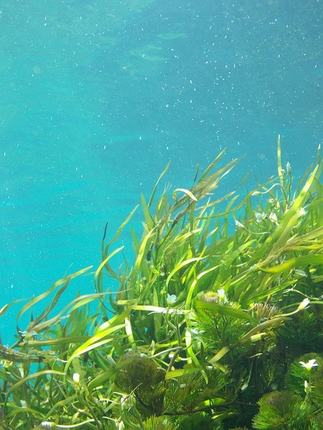 saline pool algae
saline pool algae
Evidently Disinfecting the pool water with saline electrolysis equipment will help prevent algae from becoming so easily present in the pool. But we just have to think that there are also vast expanses of algae in the sea.
So, we invite you to click on our page Green water saline pool to learn about algae prevention methods in the pool and find out the solutions.
Generic shock treatment to combat saline pool algae
Steps to follow when performing shock treatment
- Apply shock chemical: shock chlorine (minimum 70% chlorine).
- Most common chemical for shock treatment: Liquid or tablet shock chlorine, Active oxygen, Liquid oxygen.
- We fill a bucket with water according to the product instructions and m3 pool water.
- Stir the water in the bucket so that the product is dissolved.
- Pour the contents of the bucket near a pool return nozzle (preferably in the skimmer basket), little by little, so that it mixes.
